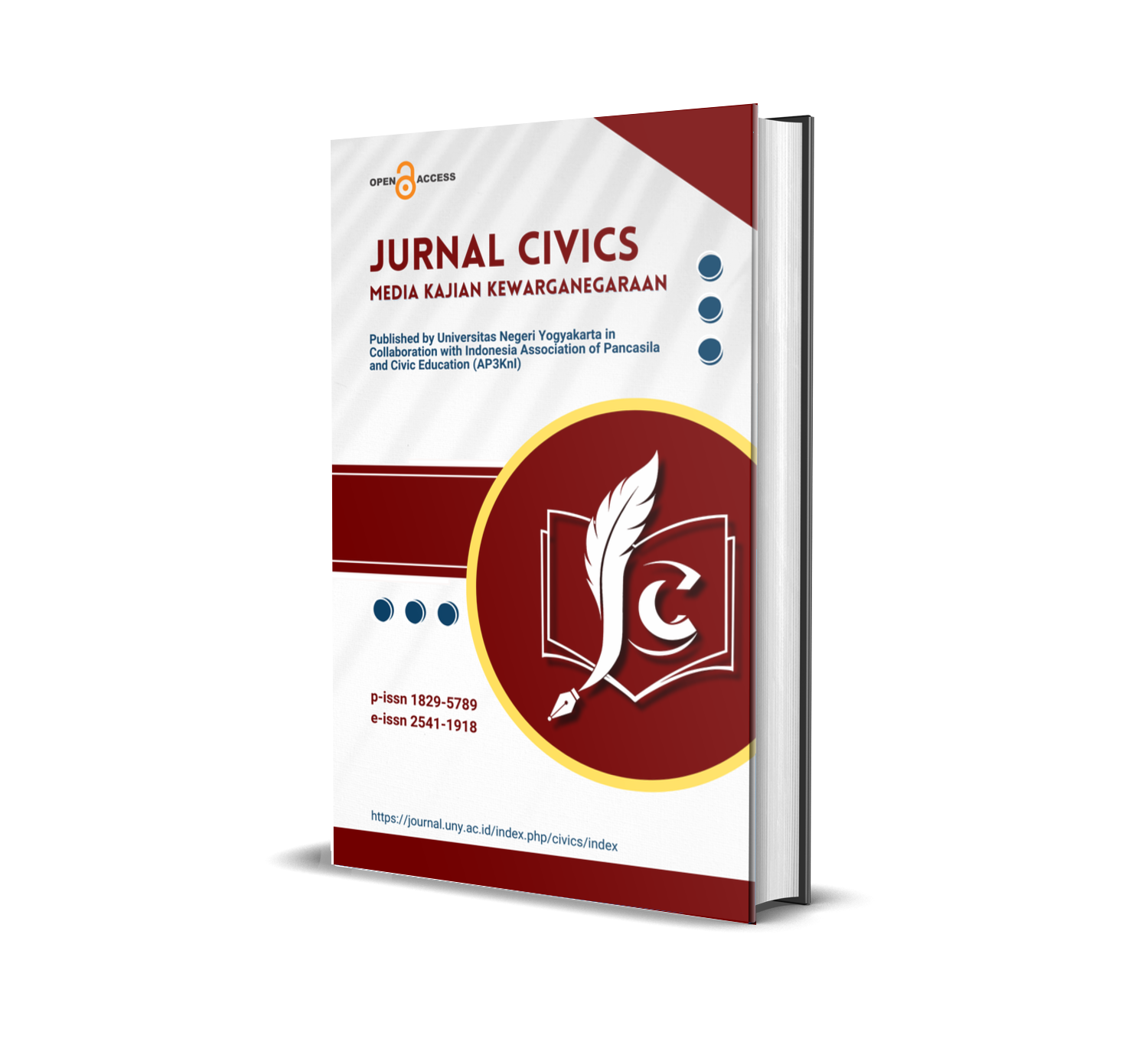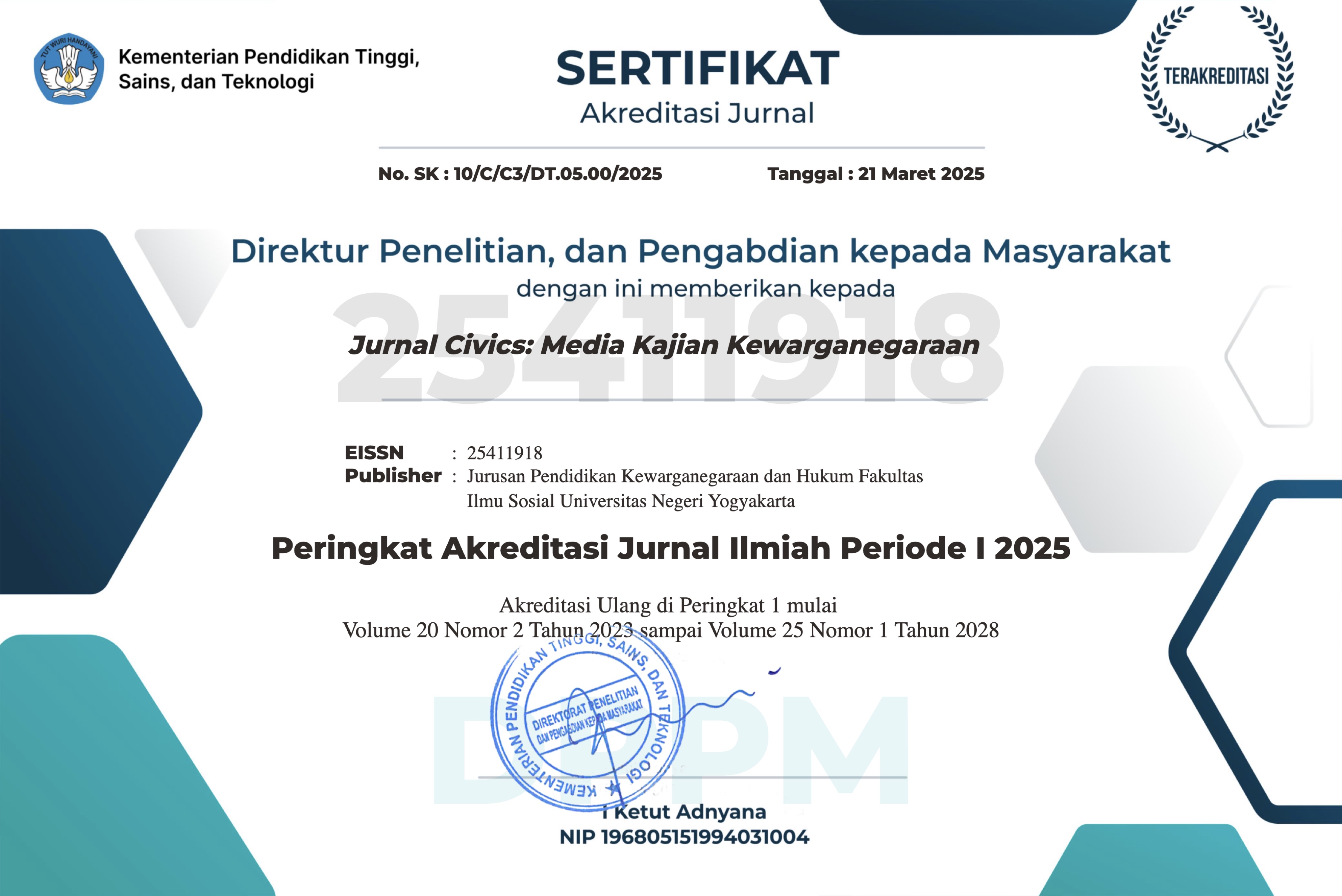Exploring character education through batik Pekalongan local wisdom: An innovative approach to character learning
DOI:
https://doi.org/10.21831/jc.v20i2.57000Keywords:
character education, local wisdom, Batik PekalonganAbstract
This research investigates the capacity of incorporating indigenous knowledge into the traditional craft of Batik Pekalongan to promote character education and facilitate learning. Batik Pekalongan, an Indonesian textile, is a cultural legacy extending beyond its conventional fabric use. UNESCO has officially designated it as an intangible cultural treasure. The study technique used is a qualitative literature review. The results indicate that including Batik Pekalongan in the curriculum may successfully cultivate robust character attributes in children, including honesty, collaboration, and responsibility. Engaging in partnerships with local batik communities and artists may further enrich students' educational experience via their direct involvement in the batik-making process. This research emphasizes the possibility of using indigenous wisdom in traditional craftsmanship to foster desirable personality qualities and provides a viable alternative to standard character education methods. By integrating indigenous knowledge, education may become more context-specific, pertinent, and efficient in fostering persons with strong moral values and principles.
References
Berkowitz, M. W. (1999). Obstacles to teacher training in character education. Action in Teacher Education, 20(4), 1–10. https://doi.org/10.1080/01626620.1999.10462930
Braver, T. S., Krug, M. K., Chiew, K. S., Kool, W., Westbrook, J. A., Clement, N. J., Adcock, R. A., Barch, D. M., Botvinick, M. M., Carver, C. S., Cools, R., Custers, R., Dickinson, A., Dweck, C. S., Fishbach, A., Gollwitzer, P. M., Hess, T. M., Isaacowitz, D. M., Mather, M., … Somerville, L. H. (2014). Mechanisms of motivation–cognition interaction: Challenges and opportunities. Cognitive, Affective, & Behavioral Neuroscience, 14(2), 443–472. https://doi.org/10.3758/s13415-014-0300-0
Creswell, J. W. (2014). Research design: Qualitative, quantitative, and mixed methods approaches. SAGE Publications.
Destiana, I., Salman, A., & Rahim, Mohd. H. Abd. (2013). Penerimaan media sosial: Kajian dalam kalangan pelajar universiti di Palembang. Jurnal Komunikasi: Malaysian Journal of Communication, 29. https://api.semanticscholar.org/CorpusID:146323231
Fajarini, U. (2014). Peranan kearifan lokal dalam pendidikan karakter. Sosio-Didaktika: Social Science Education Journal, 1(2), 123–130. https://doi.org/10.15408/sd.v1i2.1225
Febriani, R., Knippenberg, L., & Aarts, N. (2023). The making of a national icon: Narratives of batik in Indonesia. Cogent Arts & Humanities, 10(1). https://doi.org/10.1080/23311983.2023.2254042
Ghufronudin, G., Zuber, A., & Demartoto, A. (2018). Representasi pendidikan-karakter berbasis kearifan lokal melalui pembelajaran membatik. Jurnal Analisa Sosiologi, 6(2), 30–37. https://doi.org/10.20961/jas.v6i2.18020
Hidayah, S. A., & Apriliani, R. Aj. EP. (2019). Analisis pengaruh brand image, harga, kualitas, produk, dan daya tarik promosi terhadap minat beli ulang konsumen batik pekaloangan (Studi pada pasar grosir setono batik Pekalongan). Journal of Economic, Business and Engineering (JEBE), 1(1), 24–31. https://ojs.unsiq.ac.id/index.php/jebe/article/view/872
Hidayati, N. A., Waluyo, H. J., Winarni, R., & Suyitno, S. (2020). Exploring the implementation of local wisdom-based character education among Indonesian higher education students. International Journal of Instruction, 13(2), 179–198. https://doi.org/10.29333/iji.2020.13213a
Jones, T. (2018). International intangible cultural heritage policy in the neighbourhood: an assessment and case study of Indonesia. Journal of Cultural Geography, 35(3), 362–387. https://doi.org/10.1080/08873631.2018.1429351
Kartika, T. (2016). Verbal communication culture and local wisdom : The value civilixation of indonesia nation. Lingua Cultura, 10(2), 89–93. https://doi.org/10.21512/lc.v10i2.1424
Kristjánsson, K. (2016). Aristotelian character education: A response to commentators. Journal of Moral Education, 45(4), 527–534. https://doi.org/10.1080/03057240.2016.1244050
Larasati, M. (2021). Pelestarian budaya batik nusantara sebagai identitas kultural melalui pameran di Museum Batik Pekalongan pada masa Covid-19. Tornare: Journal of Sustainable and Research, 3(1), 46–50. http://jurnal.unpad.ac.id/tornare/article/view/29849
Lickona, T. (1992). Educating for character: How our schools can teach respect and responsibility. Bantam.
Lickona, T. (1999). Character education: Seven crucial issues. Action in Teacher Education, 20(4), 77–84. https://doi.org/10.1080/01626620.1999.10462937
Oleynick, V. C., Thrash, T. M., LeFew, M. C., Moldovan, E. G., & Kieffaber, P. D. (2014). The scientific study of inspiration in the creative process: Challenges and opportunities. Frontiers in Human Neuroscience, 8. https://doi.org/10.3389/fnhum.2014.00436
Purdey, J., & Savirani, A. (2016). Survival against the odds. South East Asia Research, 24(3), 407–419. https://doi.org/10.1177/0967828X16659731
Ratana-Ubol, A., & Henschke, J. A. (2015). Cultural learning processes through local wisdom. International Journal of Adult Vocational Education and Technology, 6(2), 41–60. https://doi.org/10.4018/ijavet.2015040104
Salma, I. R. (2016). Corak etnik dan dinamika batik pekalongan. Dinamika Kerajinan Dan Batik: Majalah Ilmiah, 30(2), 85–97. http://ejournal.kemenperin.go.id/dkb/article/view/1113
Santika, I. W. E. (2020). Pendidikan karakter pada pembelajaran daring. Indonesian Values and Character Education Journal, 3(1), 8–19. https://doi.org/10.23887/ivcej.v3i1.27830
Sudjatnika, T. (2017). Nilai-nilai karakter yang membangun peradaban manusia. Al-Tsaqafa: Jurnal Ilmiah Peradaban Islam, 14(1), 127–140. https://doi.org/10.15575/al-tsaqafa.v14i1.1796
Susanty, A., Handayani, N. U., & Jati, P. A. (2013). Analisis faktor faktor yang mempengaruhi pertumbuhan klaster batik pekalongan (studi kasus pada klaster batik kauman, pesindon dan jenggot). J@TI UNDIP : JURNAL TEKNIK INDUSTRI, 8(1), 1–14. https://doi.org/10.12777/jati.8.1.1-14
Wagiran. (2013). Pengembangan karakter berbasis kearifan lokal hamemayu hayuning bawana. Jurnal Pendidikan Karakter, 3(3), 329–339. https://doi.org/10.21831/jpk.v0i3.1249
Widadi, Z. (2019). Pemaknaan batik sebagai warisan budaya tak benda. Pena Jurnal Ilmu Pengetahuan Dan Teknologi, 33(2), 17. https://doi.org/10.31941/jurnalpena.v33i2.897
Downloads
Published
How to Cite
Issue
Section
Citation Check
License
The authors agree to transfer the transfer copyright of the article to The Jurnal Civics: Media Kajian Kewarganegaraan effective if and when the paper is accepted for publication.
Authors and other parties are bound to the Creative Commons Attribution-NonCommercial-ShareAlike 4.0 International License for the published articles, legal formal aspect of journal publication accessibility refers to Creative Commons Attribution-NonCommercial-ShareAlike 4.0 International License (CC BY-NC-SA).










